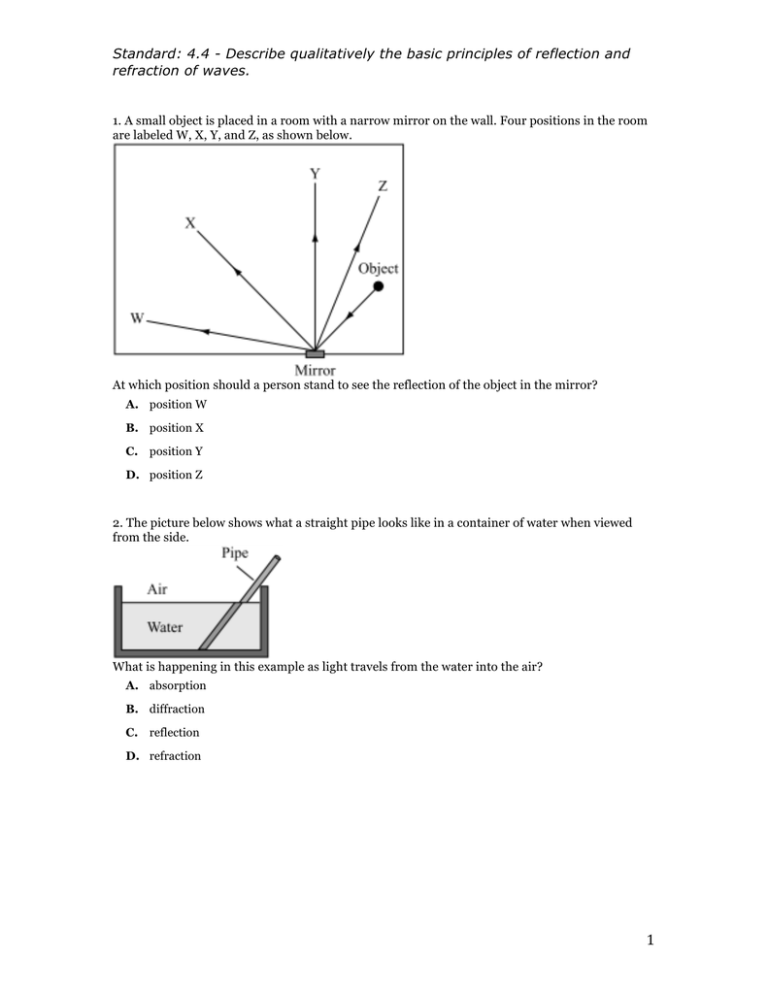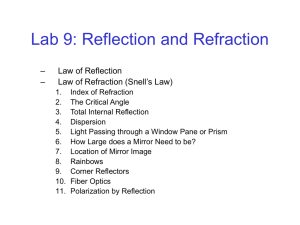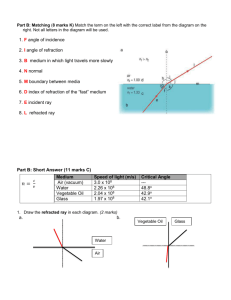Standard: 4.4 - Describe qualitatively the basic principles of
advertisement

Standard: 4.4 - Describe qualitatively the basic principles of reflection and refraction of waves. 1. A small object is placed in a room with a narrow mirror on the wall. Four positions in the room are labeled W, X, Y, and Z, as shown below. At which position should a person stand to see the reflection of the object in the mirror? A. position W B. position X C. position Y D. position Z 2. The picture below shows what a straight pipe looks like in a container of water when viewed from the side. What is happening in this example as light travels from the water into the air? A. absorption B. diffraction C. reflection D. refraction 1 Standard: 4.4 - Describe qualitatively the basic principles of reflection and refraction of waves. 3. Which of the following always occurs when a light ray reflects off a mirror? A. The speed of the light ray increases. B. The direction of the light ray stays the same. C. The frequency of the light ray decreases as it reflects and loses energy to the mirror. D. The angle at which the light ray strikes the mirror equals the angle at which it reflects. 4. The diagram below is a simplified representation of the inside of a certain type of camera. a. Identify and describe the wave behavior as the light rays pass through the glass lens. b. Identify and describe the wave behavior as the light rays strike the mirror. c. Copy the dotted box from the camera diagram into your Student Answer Booklet. Draw what must happen inside the box for light ray 2 to strike the viewfinder. Be sure to include the following: • either a lens or a mirror that is labeled • the path of light ray 2 • a line normal to the surface where light ray 2 strikes 5. Which of the following statements explains why light is refracted as it moves from air into glass? A. The speed of light decreases in glass. B. The energy of light increases in glass. C. The frequency of light decreases in glass. D. The wavelength of light increases in glass. 2 Standard: 4.4 - Describe qualitatively the basic principles of reflection and refraction of waves. 6. Which of the following diagrams represents the refraction of waves? A. B. C. D. 3 Standard: 4.4 - Describe qualitatively the basic principles of reflection and refraction of waves. 7. The diagram below shows a light ray striking the flat surface of a piece of clear hard plastic at an angle of Light travels faster in air than through plastic. Which of the following diagrams shows how the ray is refracted after it travels through the plastic? A. B. C. D. 4 Standard: 4.4 - Describe qualitatively the basic principles of reflection and refraction of waves. 8. The diagram below shows a light ray striking a plane mirror surface at an angle of 40° to the normal. Which of the following diagrams shows the ray that is reflected from the plane mirror surface? A. B. 5 Standard: 4.4 - Describe qualitatively the basic principles of reflection and refraction of waves. C. D. 9. A student standing on the edge of a swimming pool sees a painted mark on the bottom of the pool. The mark appears to be at a shallower depth than the actual depth of the pool. Which of the following descriptions of light waves best explains this observation? A. Light from the mark travels through the water in a curved path. B. Light from the mark is refracted as it travels from the water to the air. C. Light from the mark is reflected as it travels from the water to the air. D. Light from the mark bounces off the boundary between the water and the air. 6 Standard: 4.4 - Describe qualitatively the basic principles of reflection and refraction of waves. 10. The diagram below shows what happens when a particular light wave strikes a boundary. a. Identify each light ray, A, B, and C, as an incident, a refracted, or a reflected ray. b. Describe the relationship between angles x1 and x2. c. Describe how this setup could be changed so that the size of angle x3 is different. 7



